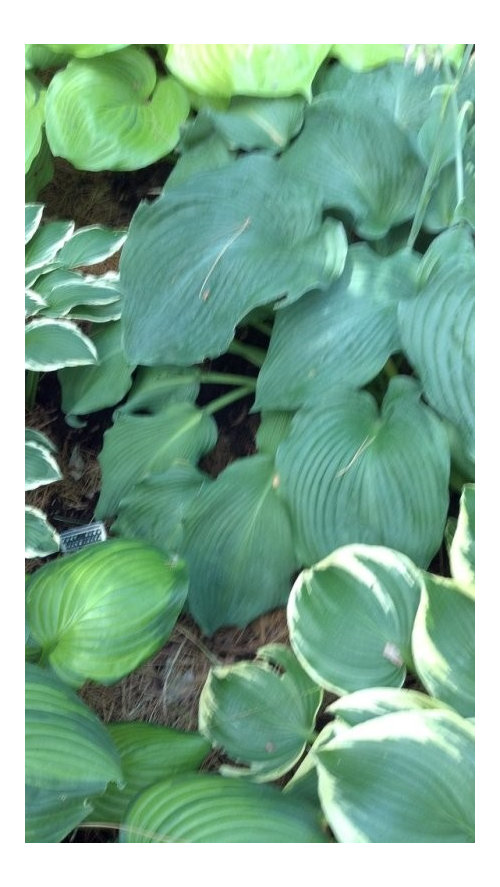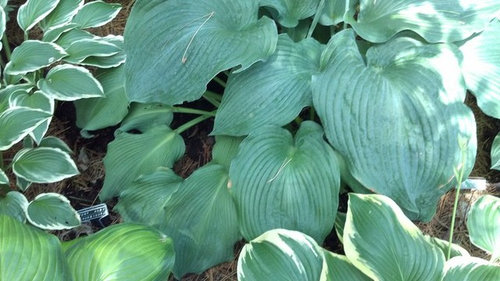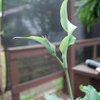Tree Root Strangulation Redux
hostahillbilly
11 years ago
Related Stories

MOST POPULARWhy We Love Midcentury Modern Design
There's a method to all this 'Mad Men'-ness — just look to psychology, tough times and, believe it or not, Apple
Full StoryIn the last week I found two more tree root strangulation examples.
Here's some pics of one of them: Hosta 'Dorothy':


Note a few of the previously mentioned symptoms;
The color of the affected leaves are waaaay different from the healthy, normal ones (see leaves down there from 7:00 o'clock to around 9:00 o'clock.
The symmetry from the center rib is off, as in uneven from one side to the other.
The effected leaves are lying down compared to the near-by healthy ones.
Last, note that the leaf edges are much more wavey than the parent plant (on some plants that may be a difficult distinction, huh?)
My wife, hostabevie, used a shovel to cut all around this in hopes of severing the invading tree roots but my past experience says this won't really work, as the tree roots are still there 'choking' the oxygen from the Hosta.
In any event, this will have to be dug out, be de-tree-rooted, and replaced, and given the size of this gal, that's going to be a real chore.
No adjacent plants show any signs of trouble, and that's not entirely uncommon, though in future years may, oddly enough, it's not always the case.
I hope the pics are good enough to show what's going on.
I've let a few other plants go beyond this early indication of trouble, even to the point of losing them.
This post is my attempt to keep you from losing some special plant. This is our only Hosta 'Dorothy' and is the parent of the sport of my wife's special Hosta 'Beauty Queen', so I'm very concerned about rescueing her.
That brings up another possible thread, 'Hostas You've Rescued'. I, somewhat recently, posted the rescue of Hosta 'Wylde Green Cream' that I'm so happy about. What about yours? New thread, methinks.
Lemme think, most popular threads here: HVX, Alphabet Hostas Lists, NOIDS, Slugs, New Orders Received, Weather, interesting pics,
but, as Alton Brown sez, that's another show (but I'm hoping this will cause y'all to start more fun, fast threads here.
gone,
hh


irawon
User
Related Professionals
Berkeley Heights Landscape Contractors · Camp Verde Landscape Contractors · San Pedro Landscape Contractors · South Hackensack Landscape Contractors · Waldorf Landscape Contractors · Mount Vernon Driveway Installation & Maintenance · Mays Chapel Fence Contractors · Oxnard Fence Contractors · Ramona Fence Contractors · San Mateo Fence Contractors · South San Francisco Fence Contractors · Foster City Fence Contractors · Milwaukie Fence Contractors · Nipomo Fence Contractors · Western Springs Solar Energy Systemsken_adrian Adrian MI cold Z5
hostahillbillyOriginal Author
ken_adrian Adrian MI cold Z5
lavenderlver
ken_adrian Adrian MI cold Z5
User
lavenderlver
hostahillbillyOriginal Author
gardenfanatic2003
ken_adrian Adrian MI cold Z5
tsugajunkie z5 SE WI ♱
ken_adrian Adrian MI cold Z5
User
hostahillbillyOriginal Author
hostahillbillyOriginal Author
jan_on zone 5b
in ny zone5
hostahillbillyOriginal Author
hostahillbillyOriginal Author
in ny zone5